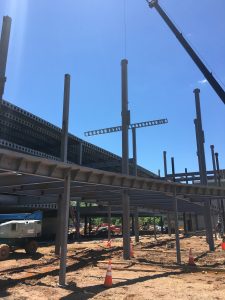What Are Cellular Beams?
Cellular beams can be a real game-changer for any construction project you are working on. From a small office building to a major sports stadium, cellular beams offer a wide variety of construction advantages. However, many people are unsure of how cellular beams work, or even what they are. That’s why we put together this comprehensive guide!
What Are Cellular Beams?
We’ve prepared a solid guide to cellular beams, including the many benefits they can offer a new construction project. First, though, we must answer a more fundamental question: what are they?
These beams are broadly similar to castellated beams (more on this later) and have been designed with circular patterns inside their webs. The main design goal of cellular beams was efficiency, as these allows architects and engineers to achieving long, stable spans without using excess amounts of steel.
In terms of both construction and design, these beams are very versatile. They are very sturdy, offering stability and support for some of the largest construction projects. And the same time, they are surprisingly lightweight, making cellular beams easier to work with and easier to build a schedule around.
Through either painting or galvanizing the beams, it is possible to drastically alter their appearance without sacrificing the stability that you need. This is one more way in which cellular beams are versatile, allowing you to perfectly recreate the designs of your dreams.
Overall, they are great to work with. However, many people confuse them with castellated beams. Therefore, it’s important to understand the similarities and differences between these two kinds of beams.

Difference Between Cellular and Castellated Beams
In terms of how they are used, there are actually more similarities between cellular and castellated beams than there are differences. Each is used as a lightweight building solution that offers long spans and a sturdy design. In this sense, the primary differences between these two types of beams is in the little details.
One such detail is something that we touched on earlier. Cellular beams are built with circular patterns for holes, whereas castellated beams are built with hexagonal patterns for holes.
While castellated beams can also be customized, it is more common for architects and engineers to work with cellular beams when they need a lot of design versatility. This is because the geometry of the parts of this beam can easily be modified for any kind of structural or aesthetic needs that you may have.
That level of versatility is why an increasing number of buildings have been designed with cellular beams instead of castellated beams. At the end of the day, it’s easier to achieve a wider array of designs and styles with cellular beams, and that’s very important for companies who consider the visual appeal of their buildings as an extension of their brand.
The Benefits of Using Cellular Beams
We’ve already discussed many of the advantages of using cellular beams. However, it’s worth revisiting these advantages and going a bit more in depth for how these beams can help you and your business.
First, these beams represent a highly efficient use of steel. That means that relying on cellular beams is a great way to cut down on the costs of a project while also ensuring that every part of your building’s interior is perfectly balanced.
The long spans of cellular beams are also useful for setting up modern building mechanical routing. Specifically, many modern buildings must accommodate a wide variety of pipes, wires and cables to help power everything from the lights to the internet and enable all plumbing systems. It can be difficult to snake such wiring and piping through the interior of many buildings, but the long spans of cellular beams makes it a snap!
The ease with which you can set up wiring through the beams also helps you create specific kinds of structures. For instance, anything that needs to be well-lit is easier to create using cellular beams. This includes spaces like parking garages and bus terminals. Lighting is important in these areas as it also plays a major part in the area’s overall safety!
Finally, it’s very easy to alter the look of a cellular beam without jeopardizing its performance. By galvanizing or painting the surface of the beam, you can achieve the aesthetic of your dreams while still enjoying a strong foundation. And did we mention the insanely competitive price?
Ideal Buildings for Cellular Beams
So far, we’ve talked a lot about the benefits of cellular beams and how they can be used to help you create a variety of structures. But talk, as they say, is cheap. Which is why we’d like to review some of the best buildings in the world where the designers have chosen to use these beams.
At the University of Wisconsin Oshkosh, they recently built a 40,000 square foot alumni center using cellular beams. The wide span of the beams ended up being a natural fit for this two-story structure which included many wide interior spaces such as banquet meeting areas. In addition to structural stability, the actual appearance of the cellular beams contributed to the open and accessible vibe they were going for.
Additionally, the Cuyahoga Public Library in Warrenville Heights, OH was recently constructed using composite cellular beams. The composite use allowed them to keep the cost down without sacrificing their visual appeal. In fact, the tapered appearance of the top of the building helps give it a look that is truly dynamic and engaging.
Finally, a recent Mercedes Benz dealership in Bridgewater, NJ was constructed using cellular beams. While structural stability was important, Mercedes primarily chose the cellular beam for its aesthetic appeal. With the ability to shape any and every beam as desired, Mercedes was able to continue their longstanding tradition of intense visual appeal for their consumers.
Conclusion
Now you know what cellular beams are and how they completely change the game when it comes to construction. But knowledge is just the beginning.
If you have a major construction project around the corner, be sure to choose cellular beams. Just be ready, though, for how much this choice completely transforms your concept of construction!





